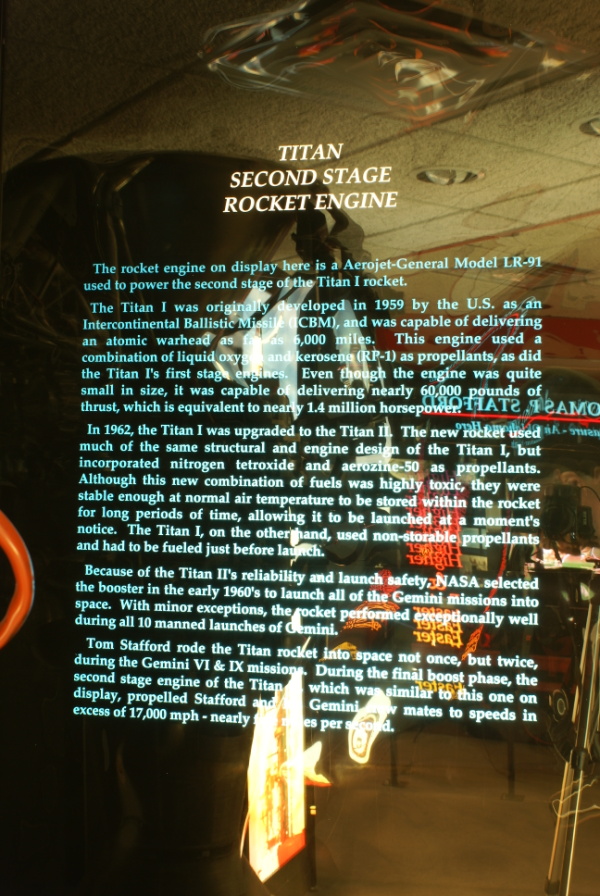| Prev |
heroicrelics.org Stafford Air & Space Museum Site Index LR-91 Engine Gallery |
Next |
dsc46345.jpg
The sign accompanying the LR-91 engine. It reads
Titan Second Stage Rocket Engine
The rocket engine on display here is an Aerojet-General Model LR-91 used to power the second stage of the Titan I rocket.
The Titan I was originally developed in 1959 by the U.S. as an Intercontinental Ballistic Missile (ICBM), and was capable of delivering an atomic warhead as far as 6,000 miles. This engine used a combination of liquid oxygen and kerosene (RP-1) as propellants, as did the Titan I's first stage engines. Even though the engine was quite small in size, it was capable of delivering nearly 60,000 pounds of thrust, which is equivalent to nearly 1.4 million horsepower.
In 1962, the Titan I was upgraded to the Titan II. The new rocket used much of the same structural and engine design of the Titan I, but incorporated nitrogen tetroxide and aerozine-50 as propellants. Although this new combination of fuels was highly toxic, they were stable enough at room temperatures to be stored within the rocket for long periods of time, allowing it to be launched at a moment's notice. The Titan I, on the other hand, used non-storable propellants and had to be fueled just before launch.
Because of the Titan II's reliability and launch safety, NASA selected the booster in the early 1960's to launch all of the Gemini missions into space. With minor exceptions, the rocket performed exceptionally well during all 10 manned launches of Gemini.
Tom Stafford rode the Titan rocket into space not once, but twice, during the Gemini VI & IX missions. During the final boost phase, the second stage engine of the Titan II, which was similar to this one on display, propelled Stafford and his Gemini crew mates to speeds in excess of 17,000 mph - nearly five miles per second.
Although I am not especially familiar with the differences between the versions of the LR-91 used in the Titan I vs. the Titan II, I believe that the Titan I version of this engine should be outfitted with four vernier nozzles, so this may well be a Titan II version of the LR-91.
Also, this description paints a bit of a rosy picture regarding the Titan II's role in Gemini. As described toward the middle of Chapter 2 of On The Shoulders of Titans: A History of Project Gemini, NASA expressed initial interest in the Titan II simply because it was more powerful than the Atlas used in Project Mercury; the Titan II had the additional thrust required to send the heavier Gemini spacecraft into orbit. Chapters 6 and 7 detail some of the challenges to be overcome before the Titan II would prove itself to be a reliable manned launch vehicle.

| Time picture taken | Thu Jul 31 08:42:14 2008 |
| Location picture taken |
Tom Stafford History Room Stafford Air & Space Museum Weatherford, Oklahoma |
| Prev |
heroicrelics.org Stafford Air & Space Museum Site Index LR-91 Engine Gallery |
Next |